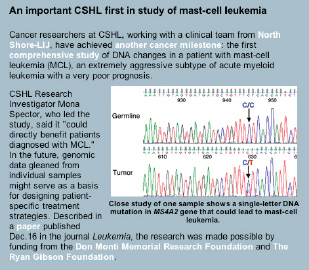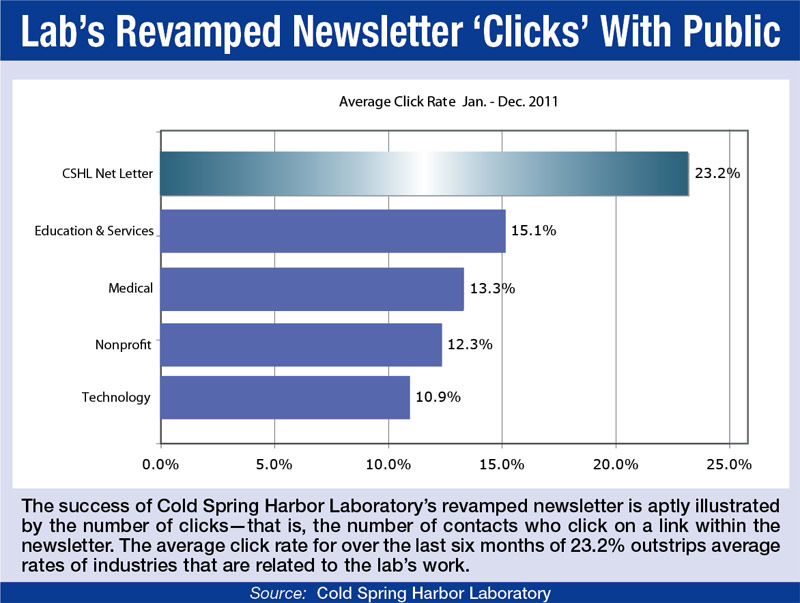 |
| When Cold Spring Harbor Laboratory began revamping its NetLetter to appeal to a broader audience, part of the effort was to present content like the above story that features links to more detailed information. Image Courtesy of Cold Spring Harbor Laboratory |
Organization: Cold Spring Harbor Laboratory
Timeframe: Jan. 2011 - Present
It’s not easy to take complex material and make it pop among the lay public while still maintaining credibility among highly specialized peers. Theoretical physicist Stephen Hawking and the late astronomer Carl Sagan are two notable exceptions. But that’s exactly what Cold Spring Harbor Laboratory (CSHL) had in mind in a drastic redesign of its monthly NetLetter.
The private, not-for-profit research and education institution for molecular biology and genetics—located in the seaside Long Island community made famous by Billy Joel’s 1971 album bearing its name—has a stable of talented scientists that continually place it among the top 1% of life science institutions most cited in published research around the world. CSHL is less well known outside of the scientific community, but in January 2011 the lab’s three-person public affairs team set out to change that. The NetLetter, formerly managed by CSHL’s donor-development team, was taken on by the public affairs team to increase awareness of CSHL, rather than just secure donations.
In the spirit of scientific discovery, you may ask: Why should CSHL care about the general public’s awareness of its research? Because federal grants comprise only about a third of CSHL’s revenues, and the laboratory has come to rely more heavily on donations from private foundations and individuals to fund its programs.
RAISING AWARENESS
To promote the lab’s scientific contributions to non-science constituents—including members of neighboring communities, philanthropic supporters, government officials and disease advocacy organizations—the public affairs team, led by VP Dagnia Zeidlickis, would revamp the NetLetter to better align with the public affairs team’s outreach goals: to communicate the vital contribution that scientific research at CSHL makes toward improving health, and the significant impact of CSHL’s educational programs on raising the public’s awareness of science.
The NetLetter is a key component of the CSHL’s communications program for engaging these constituencies on a consistent basis, and would be redesigned to be a highly interactive and visually appealing platform that delivers news and information about CSHL that is both useful and relevant to a diverse audience.
“We wanted to have our communication with the external world represent the incredibly high level of activity and dynamic nature of the research and education that we do, and our previous approach to the Internet and NetLetter was, in our view, not representative of that,” says Zeidlickis. “We wanted to become more lively and interactive with the outside world.”
The NetLetter-specific objectives included:
• Reaching diverse audiences: Covering multiple categories of news across the spectrum of CSHL’s activities that will engage and inform the lay public and targeted audiences—including journalists, scholars, investors, elected officials, teachers, grant officers, CHSL employees and scientists at other institutions; parents and students (elementary through high school, undergraduate and graduate levels); and institutional supporters.
• Promote programs and initiatives: Generate awareness of lectures and cultural programs; fund-raisers; registration deadlines for various CSHL programs; as well as news about prizes, honors, promotions and new institutional initiatives.
• Highlight media coverage: Make the CSHL audience aware of national and international news coverage of CSHL research.
• Increase the digital footprint: Drive traffic to the CSHL Web site.
• Science through social: Increase the audience following on CSHL social media outlets.
CROSSOVER DREAMS
 |
With audiences that range from hard-core scientists to Nobel Prize winners and PTA moms, how do you create a digestible resource from rich, research-heavy content? That was, and is, the challenge, says Hema Bashyam, science writer in CSHL’s public affairs department.
“Our research programs are diverse with plant biology, neuroscience and quantitative biology, and not everyone who is interested in plant science is going to care about neuroscience,” says Bashyam. “So we tried to maintain the integrity of the science while making it digestible to a broader audience.”
To meet those challenges, the CSHL public affairs team deployed a two-pronged redesign strategy:
1. To interest and engage a diverse audience, they wrote short news teasers that convey an article’s main message but also contain links to relevant pages, both on the home site and elsewhere, where the news is covered in greater detail. “We capture large, complicated stories through snippets that can catch any reader’s attention,” says Bashyam. In-depth multimedia digital content such as videos, podcasts, slideshows and blogs are also included.
2. To retain the audience, the team adopted a something-for-everyone approach in which every edition of the NetLetter includes news across several kecategories—research, education, philanthropy and upcoming events.
DISTRIBUTION SCIENCE
The NetLetter is sent out on the first working day of each month to minimize chances of e-mail getting buried in in-boxes, says Zeidlickis. Reaching beyond the already-large subscriber list—more than 6,000 strong—the NetLetter is shared on the CSHL’s Facebook and Twitter accounts, which have 1,200 and 400 followers, respectively.
“We’ve integrated social media into the NetLetter as a way to have people find us on those channels, which are then used to cross-promote back to the NetLetter,” says Zeidlickis. “We also highlight and link to external media outlets to let our readers know how the rest of the world views CSHL.”
Zeidlickis and Bashyam also look for opportunities in CSHL’s local community outreach and their personal relationships to promote the NetLetter.
“Whenever we have people coming to the lab to attend a lecture, or when our scientists make public appearances, we encourage people to sign up for the NetLetter,” says Zeidlickis. “We’re not just trying to boost the readership electronically—all of our communications programs are designed drive people to sign up.”
MEASURING TRENDS
Constant monitoring of the NetLetter reports helps determine trends such as the type of news that receives the most clicks. This data is used to modify strategy to improve open rates and click rates (see chart for open rates).
“We’re proactive on keeping up with what the audience likes,” says Bashyam, who constantly looks at the NetLetter’s stats through the e-mail service provider Constant Contact. “We experiment and watch for what happens on the back end to see whether something works.”
But mostly it works, as shown by the following results:
• The average open rate for 2011 was 35.6%, which is double the average open rate compared to several industry categories that CSHL falls under.
• The average opt-out rate for 2011 was a scant 0.2%, which suggests a loyal following.
What’s responsible for these numbers? Zeidlickis says it’s abandoning a cookie-cutter approach. “We don’t just pull the first paragraph from a press release or article and regurgitate it into the NetLetter—we take the effort to devolve the content into this format while keeping it interesting.”
Moving forward, Zeidlickis and her team want to develop a CSHL iPad and mobile application based off the NetLetter, but, like everything else, it comes down to resources and manpower. They are, however, accepting donations. PRN
For more case studies about nonprofit PR, visit PR News’ Subscriber Resource Center: prnewsonline.com/subscriber_resources.html
CONTACT:
Hema Bashyam, [email protected]; Dagnia Zeidlickis, [email protected]; Arthur Hughes, [email protected].
